Did you know that it’s a proven fact that, according to a recent study, fishkeeping is a hobby that’s great for your physical and mental wellbeing?
Well, it’s true! Aquarists can look forward to enjoying reduced heart rates and lower blood pressure, not to mention being more chilled-out folks than the average fishless person.
At first, the idea of setting up a tropical fish tank in your home and keeping it clean and healthy can be very daunting. Where do you start?!
Thankfully, our ultimate guide to being an aquarist contains everything that you need to know to begin your fishkeeping journey from novice to knowledgeable enthusiast.
The Origins Of Fishkeeping
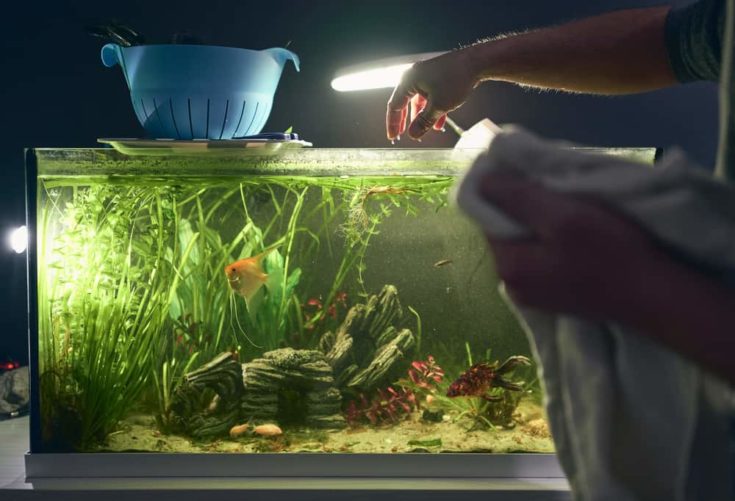
Fishkeeping as a hobby has been around for at least 4,500 years when the Sumerians kept fishes in purpose-built ponds, initially as food, but later with brightly colored specimens being kept as pets. The ancient Egyptians and Assyrians also kept species of tropical fish, making these early enthusiasts among the first known aquarists. Some of the fish were bred as food, whereas other species, which were regarded as sacred, were kept in rectangular, ornamental temple pools and revered.
China
The Chinese are thought to be the first civilization to selectively breed fish to create ornamental specimens, using freshwater carp that were originally kept as a food crop. During the Song Dynasty, goldfish were kept indoors in large, ceramic vessels. The Japanese also caught the fishkeeping bug and perfected the art of breeding of ornamental goldfish.
Ancient Rome
The ancient Romans farmed fish for food, and evidence was discovered to show that they also created decorative fish ponds, which were filled with fresh seawater and beautiful fish that were brought from the ocean, making these early enthusiasts the first marine aquarists.
Medieval Europe
Later, in Medieval Europe, ponds containing carp were regularly included in the grounds of monasteries and estates, where the fish were kept and cultivated as an alternative dish to meat on religious feast days when eating meat was forbidden.
England
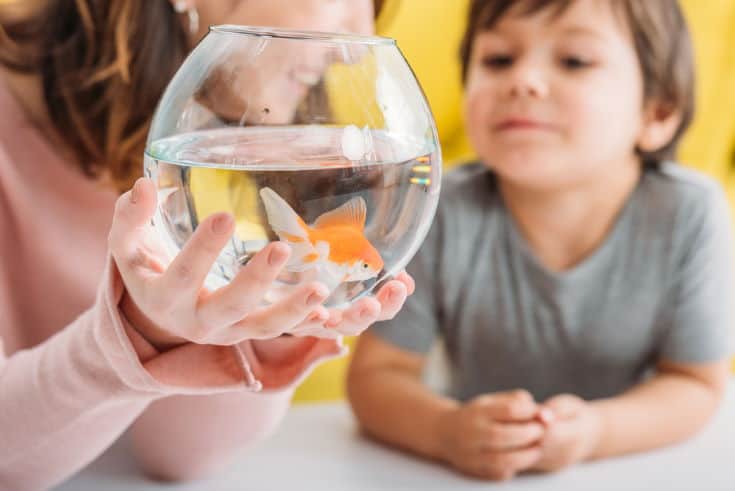
In England, during the 1700s, early hobbyists used glass vessels to keep goldfish, although it wasn’t until 1832 that Jeanne Villepreux-Power, a French naturalist, invented the very first glass aquarium.
Since those early days, fishkeeping has become much more sophisticated and is now one of the world’s most popular pet-keeping hobbies after dog and cat ownership.
Fishkeeping Systems
The kind of fishkeeping system that you use depends on the species of fish that you want to keep.
Freshwater Aquariums
Most hobbyists take their first steps on their fishkeeping journey by keeping freshwater fish.
Take a look around your local pet store, and you’ll see dozens of different freshwater species from coldwater fish, such as goldfish, to exotic-looking tropical species, including guppies, angelfish, bettas, and barbs.

Most aquarists prefer to keep a variety of species in one display tank to create an attractive and interesting focal point in their home. However, there are fish, such as bettas, that are solitary in nature, although they still make an impressive sight in a single-species setup.
As well as fish, the freshwater aquarium can be home to a huge variety of live plants, and keeping them can develop into a hobby in itself. Invertebrates, such as snails and shrimp can also make a quirky addition to a tropical freshwater tank, and they’re useful too, cleaning up algae and general detritus from the substrate.
Saltwater
Marine tanks are generally more challenging and time-consuming to maintain, and the fish, corals, anemones, and invertebrates that you can keep in saltwater are typically much costlier to purchase than freshwater livestock. For that reason, marine and reef tanks are more suited to experienced aquarists.
The brilliantly colored saltwater species that are kept in home fish tanks are mostly tropical. Temperate species prefer cool water conditions, and that’s hard to provide in an aquarium unless you use a refrigeration unit, colloquially known to hobbyists as a “chiller.”
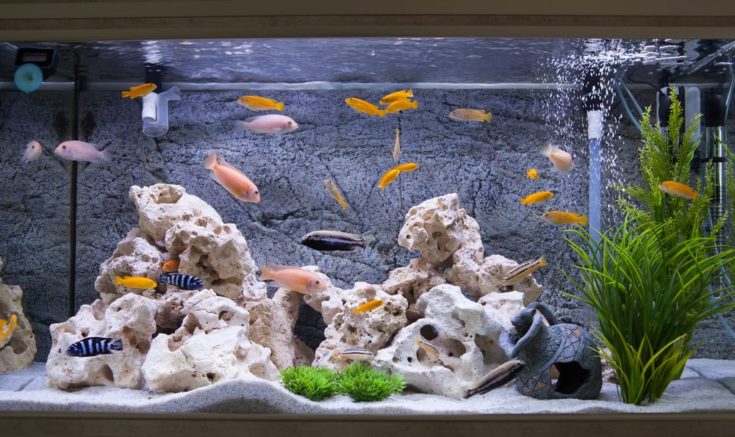
A coral reef can be created in a saltwater aquarium, using living rock, large coral species, and anemones. Reef tanks are usually home to mollusks, crabs, echinoderms, and shrimp, as well as peaceful small fish species.
Brackish Water
Some fish come from tidal estuaries and mangrove swamps where the water varies between fresh and salty. Although some of these species can also be kept in freshwater, there are lots of fish that will not thrive unless they are kept in brackish conditions.
Keeping a brackish aquarium well-balanced can be tricky, especially given that water tends to evaporate, taking with it some of the salt content. Also, the hobbyist will have to carefully balance the combination of saltwater and freshwater at each weekly partial water change.
Top Tips For Novice Aquarists
First of all, you’ll need to decide what species of fish you want to keep. I recommend that beginners start with a simple tropical setup or perhaps a single species goldfish or betta tank. That said, goldfish are messy creatures, and a tropical aquarium with a few carefully chosen specimens is generally easier to manage.
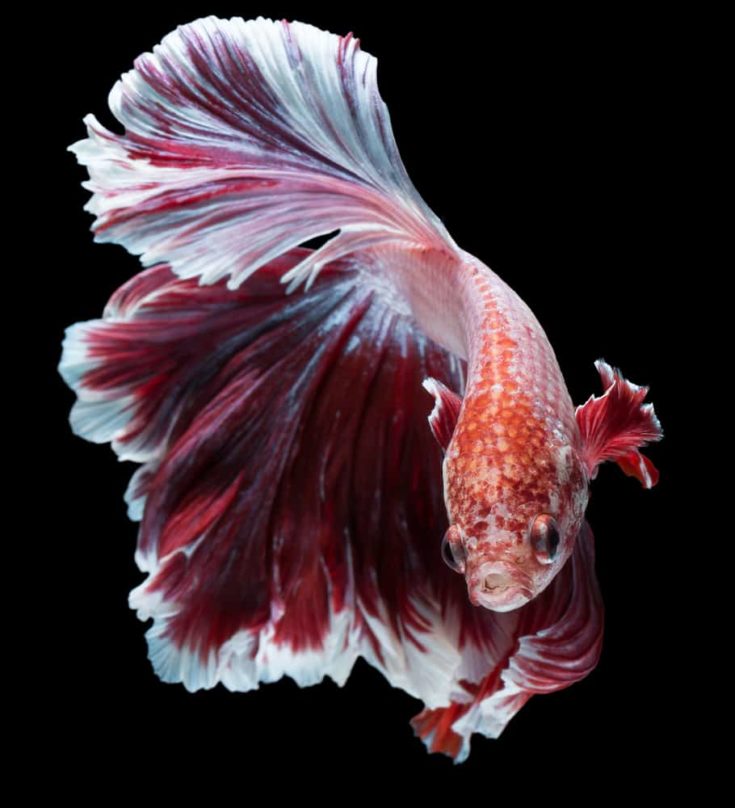
So, in this guide, we’re going to focus on setting up and maintaining a basic tropical fish tank.
What Fish Species?
The range of tropical fish species that you can choose from is nothing short of bewildering! So, how on earth do you decide which species to keep? There are several important things for the beginner aquarist to consider when selecting fish:
- What size aquarium can you have?
- How big do the fish get when they are fully grown?
- How hardy is the species?
- Is the species easy to care for?
- Is the species peaceful or aggressive?
- What’s the life expectancy of the species?
Once you’ve decided on the varieties of fish that you want to keep, do your research to make sure that all the species share the same requirements in terms of water parameters, environment, food, and temperament.
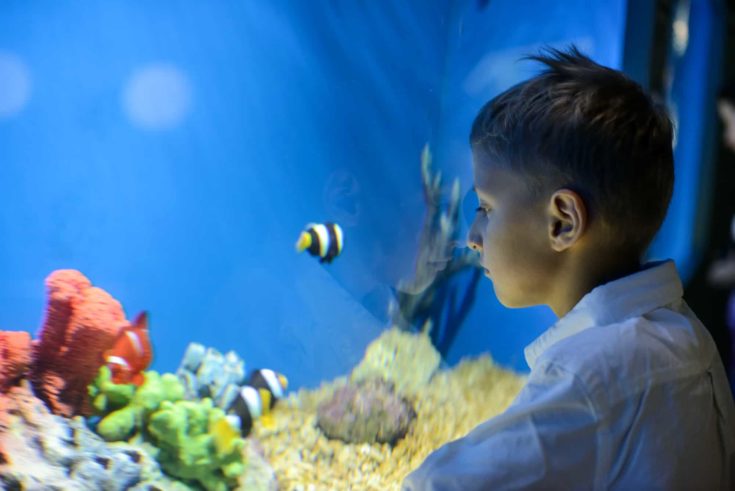
As a beginner, you’ll find it much more pleasurable and less hassle to keep fish that have similar environmental needs and care requirements. Also, you want to avoid fish that have a reputation for aggression. A peaceful tank is much more relaxing for the owner than one where the occupants are constantly scraping!
It’s also sensible to stick to the cheaper species when you first start out on your aquarist journey, rather than spending a fortune on a fish, only to have it die within a week of getting it home because the tank conditions weren’t quite right. The fish species that you can keep will be determined by the size of the tank you have.
Species For Small Tanks
If your space is limited, you can still enjoy keeping fish in a small aquarium.
Bettas are an extremely popular choice of pet fish that are beautiful to look at, peaceful when given the correct tankmates, and suitable for a beginner aquarist to take on.
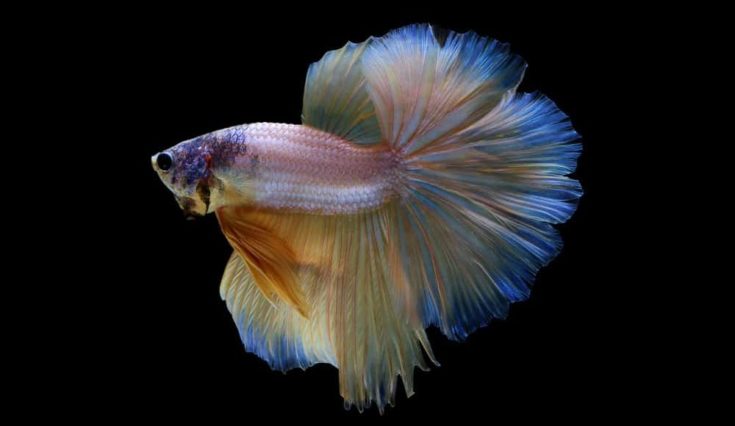
Other species that do well in nano tanks include tetras, Corydoras catfish, and danios.
Community Aquariums
Community aquariums are a very popular choice for beginners.
Choose fish that are peaceful, easy to keep, and share the same water requirements. It’s also a good idea to pick tankmates that live in different areas of the water column. That prevents competition for food and swimming space, helping to maintain harmony within the tank.
Popular community fish species include Platys, Mollies, Guppies, Corydoras catfish, Gouramis, and tetras.
What Size Fish Tank?
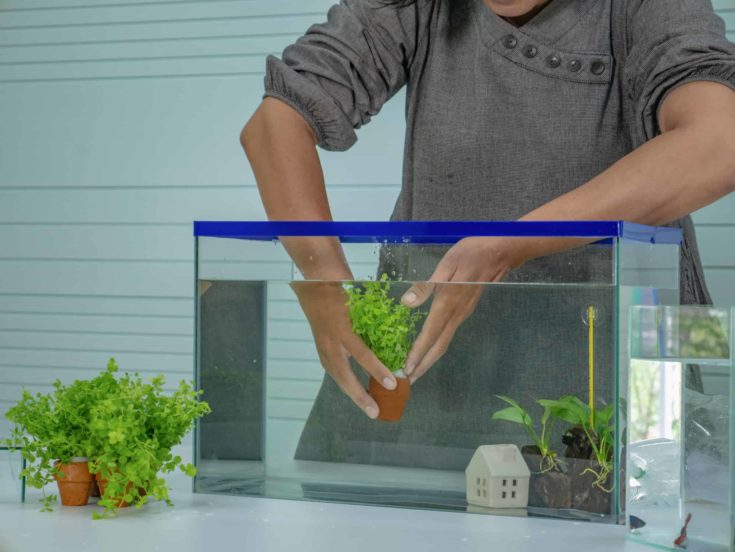
Remember that you need to allow space around your tank for maintenance and enough room for you to easily access power points. Also, you need to be able to raise the lid of the tank so that you can carry out weekly partial water changes.
Also, aquariums need a small amount of space around them to provide good ventilation so that mold and condensation don’t become a problem on surfaces adjacent to the tank.
Stable Water Temperature
It’s important that the water temperature in the tank remains constant, as fluctuations can be harmful to many species of fish. So, you must choose a site for your tank that is not in a drafty part of your home, next to a radiator, a heater, or aircon unit, and is not in a place where it will be affected by direct sunlight.
Level Flooring
The minimum size of the aquarium that you buy must be the minimum size in which the fish will thrive. Generally, the larger the tank, the better it is for the fish. A larger volume of water dilutes harmful ammonia and nitrites more efficiently, and the filtration systems in larger aquariums cycle more quickly, reducing stress on the fish.
The size of the fish tank you can choose will be decided by where you intend to keep it.
Power Source
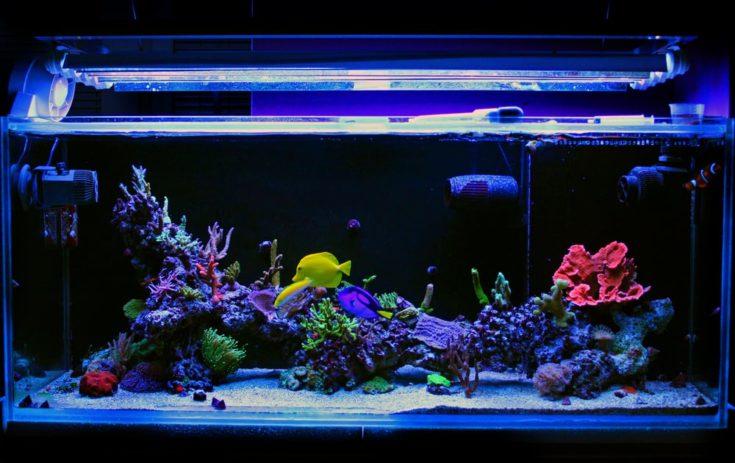
The tank will have lights, filtration equipment, and a heater, all of which need to be plugged into a mains power outlet, preferably without the need for trailing cables that could present a tripping hazard.
Also, it’s helpful if you keep the tank close to a water source so that weekly maintenance tasks and partial water changes are made easier.
Space For Access
Larger tanks usually come with an integral cabinet that’s specially designed and constructed to safely bear the weight of a fish tank full of water.
Check the flooring in the area where you intend to keep the tank and cabinet to see if it’s solid and level. An unlevel surface makes it impossible to fill the tank properly, and it could even tip over.
Choosing A Tank
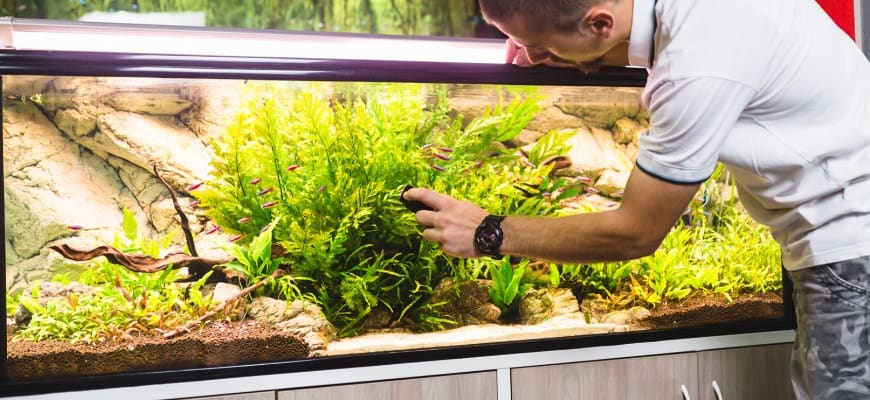
Now that you know what size tank you can have, it’s time to choose one.
Glass Or Acrylic?
Aquariums can be made from glass or plastic.
Generally, glassfish tanks are less expensive, and they are more scratch-resistant than acrylic ones. However, acrylic aquariums are much lighter when empty, making them much easier to transport. Acrylic is also stronger than glass and is, therefore, less likely to break. If you live in an area that is prone to earthquakes, it’s worth knowing that acrylic is much more forgiving than glass.
What Tank Shape To Choose
Aquariums come in a variety of shapes and sizes, some of them extremely quirky and unusual.
Rectangular tanks are the most popular choice with beginner aquarists. You can also buy bowl-shaped bioOrbs, small nano tanks, tall, square aquariums, and hexagonal tanks too. Also, you can buy rectangular tanks with bowed fronts, giving you a better all-around view of your fish.
How Many Fish?
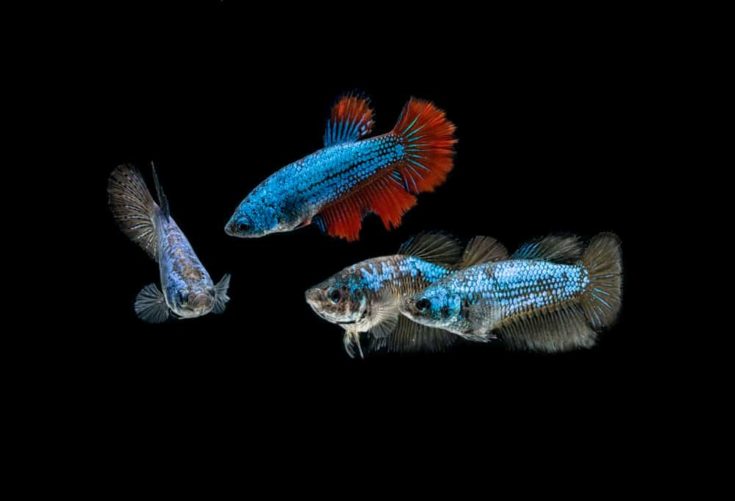
Your primary consideration when choosing a tank must be the welfare of your fish.
Overcrowding causes stress, and stress is a common cause of disease in aquarium-kept fish. So, choosing the correct size and shape of the tank is critical if your fishes are to thrive.
The general rule of thumb when it comes to calculating how many fish can be accommodated in a tank states that you should allow one gallon of water per one inch of fish. However, that doesn’t account for the shape of the tank. A better rule is based on the surface area available in the tank, rather than the volume. So, for every one inch of fish, you should allow 12 square inches (not a square foot) of surface area.
Therefore, a 40-gallon hexagonal tank would be able to accommodate around half as many fishes as a 40-gallon rectangular aquarium.
How so?
Well, a large surface area is essential for good gaseous exchange in the water. Fish need dissolved oxygen that’s obtained from the air. The smaller the surface area, the less oxygen is available in the water for the fish. A rectangular tank has a greater surface area than a hexagonal one, and can, therefore, comfortably accommodate more fish.
Aquarium Shape And Fish Species
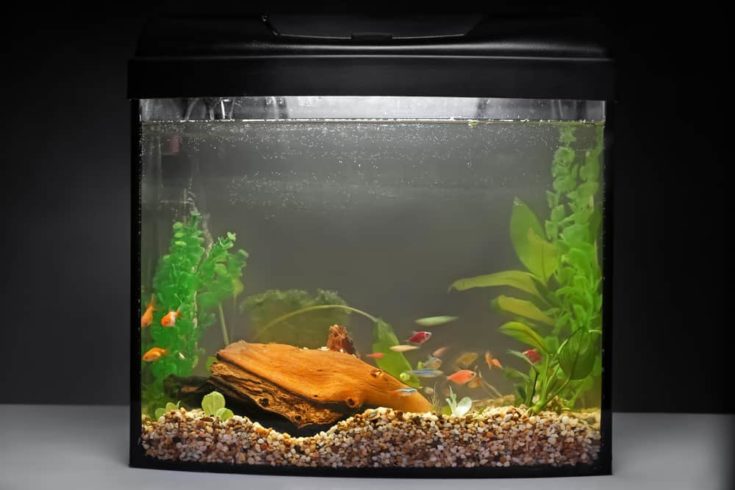
Different fish species live in different parts of the tank, and that will also have a bearing on the shape of the tank that you choose.
For example, active, free-swimming species will be happy in a rectangular tank, whereas poorer swimmers may be better in a tall, narrow aquarium. Betta fish with their heavy, flowing finnage prefer a shallow tank, as they are surface feeders, and they also need to get to the top of the tank to breathe.
For a beginner, I recommend starting out with a 10 to 15-gallon rectangular aquarium that measures around 24 inches in length. That’s a manageable size and allows you to keep a community of 15 to 20 small fish.
What Equipment Do You Need?
Although it’s true to say that you do need a fair range of equipment to set up your tropical fish tank, once you’ve bought everything, that’s it. All you need to pay for on a regular basis afterward is food for your fish and possibly some replacement filter media, depending on the system that you choose.
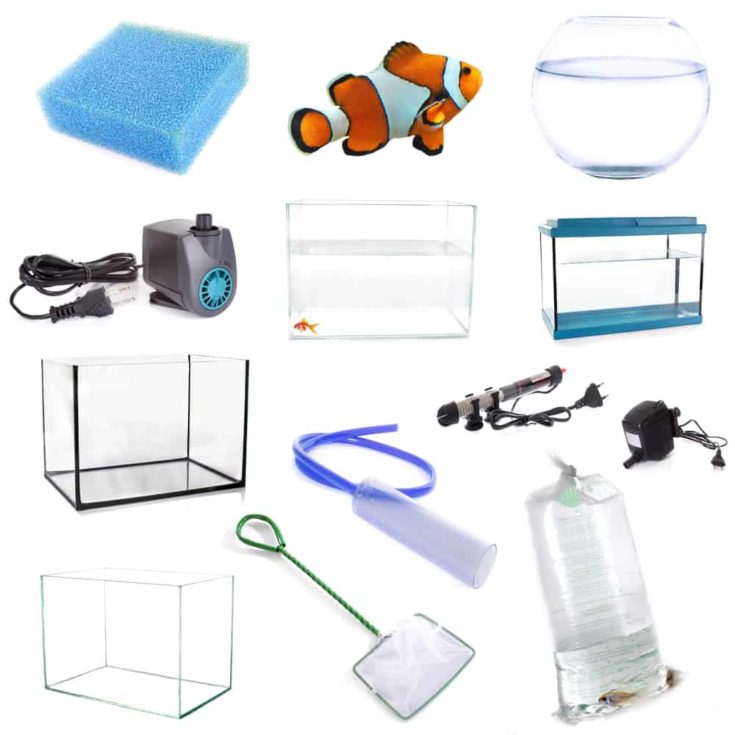
So, in addition to the aquarium, you’ll need some other equipment.
DIY Or Kit?
You can opt to take the DIY route and purchase everything separately. That enables you to customize your setup with your preferred style of filtration system, heater, lighting, etc.
Once you have some knowledge and experience under your belt, you can change things up to better suit your needs. However, when you first start out, I recommend choosing an aquarium kit. Many fish tanks come complete with all the essentials, often at a very reasonable price, and that can save you a whole lot of hassle and cash too.
Let’s look in more detail at what equipment you need:
Cabinet
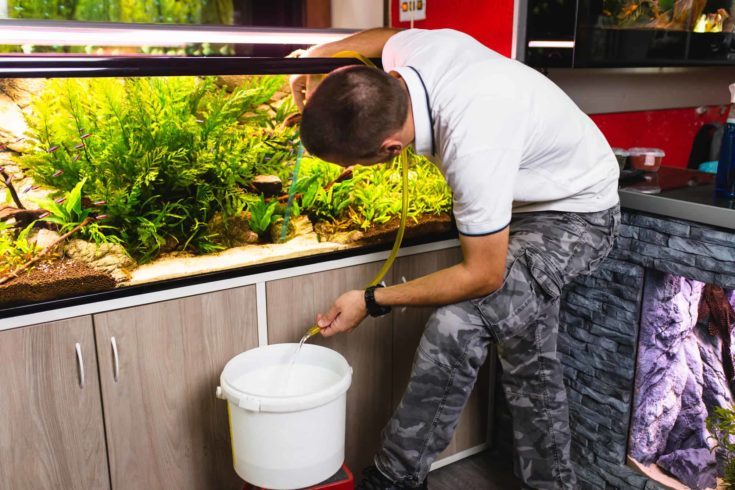
A medium-sized aquarium must be placed on a purpose-built cabinet. It’s important to know that manufacturers’ warranties are often invalid if you put a heavy fish tank on a piece of unsuitable DIY home furniture that collapses.
Cabinets also provide you with space to hide external filtration and somewhere to keep containers of food, test kits, water treatments, etc.
Heater
Tropical fish come from waters in places like Africa, Asia, and South America, where the temperature rarely falls below 75o Fahrenheit, so you will need an aquarium heater to ensure that the water in your tank stays in that range.
Fish tank heaters are thermostatic, enabling you to set the temperature that you want and maintaining it 24/7/365, which is vital for your fish, as sudden temperature changes can be very harmful to them.
When choosing a heater, pick one that offers the same or greater wattage as there are gallons of water in your tank.
Filtration
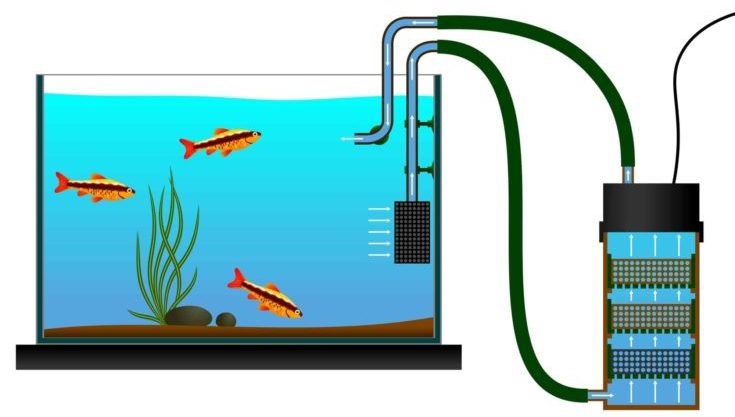
A filtration system is an essential piece of kit for an aquarium, regardless of the species of fish you have and the size of the tank. The filter should be in operation 24 hours a day, keeping the water clean and hygienic by removing harmful pollutants and fish waste.
For beginners, starting out with a medium-size or a small tank, an internal filter is the best choice, as they are simple to install and to use. If your tank doesn’t come with a filter system, ask the advice of a member of the fish store’s staff to help you choose the most suitable one for your tank.
Lighting
A collection of brightly colored, active tropical fish can look absolutely stunning when displayed under the right lighting.
Most tanks come with a built-in lighting unit, although you can swap out bulbs for others that will encourage the growth of live plants or bring out the color of your fishes. You can also buy lighting units that come with special effects, remote controls, and timers that can be set, using your tablet or smartphone.
Air Pump
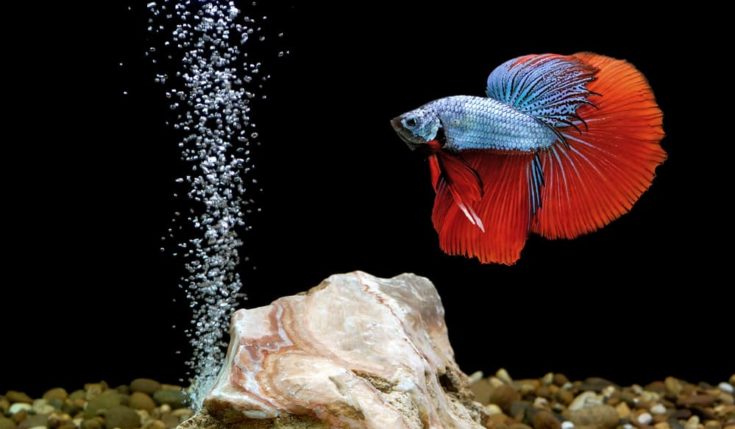
An air pump is not essential, but having one in your aquarium is beneficial for your fish. The air pump is attached to a piece of airline and an air stone. The pump blows bubbles of air into the water, helping to increase the oxygen saturation.
If your filtration system fails, the fish will still get plenty of oxygen via the air pump. Also, beneficial, aerobic bacteria that process ammonia and nitrite in the tank will benefit from the additional oxygen, making the filtration process more efficient.
The air pump can live in the cabinet underneath the tank, but you must fit a non-return valve to prevent water from getting into the pump in the event of a power outage. Alternatively, you could hang the pump from the wall behind the tank at a point above the waterline.
Substrate
Your aquarium should have a two to three-inch layer of substrate across the bottom. There are several different kinds of substrates to choose from, but the preferred option for most beginner tanks is gravel.
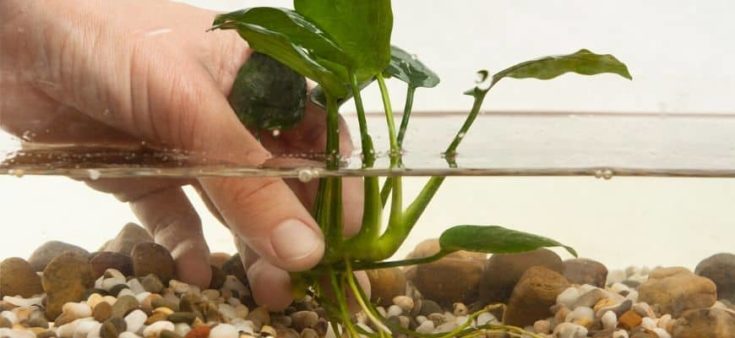
Although you can buy colored gravel, we don’t recommend it. Most colored gravel is made from a mineral called white dolomite, which is packed with calcium and magnesium. Both these naturally occurring minerals alter the pH of the water, making it unsuitable for many fish species and requiring a pH buffer to correct the water chemistry.
Pea gravel is the best choice, as it gives an attractive natural look to the aquascape, doesn’t alter the water hardness, and provides a secure rooting place for live plants.
Decorations
Most fish benefit from having places to hide and explore, so you should include some decorative items in your tank setup.
Popular choices of tank decoration include driftwood, rocks, and resin ornaments. You can also buy bogwood, sometimes with live plants growing on it. However, bogwood eventually releases tannins into the water, which stain the water brown.
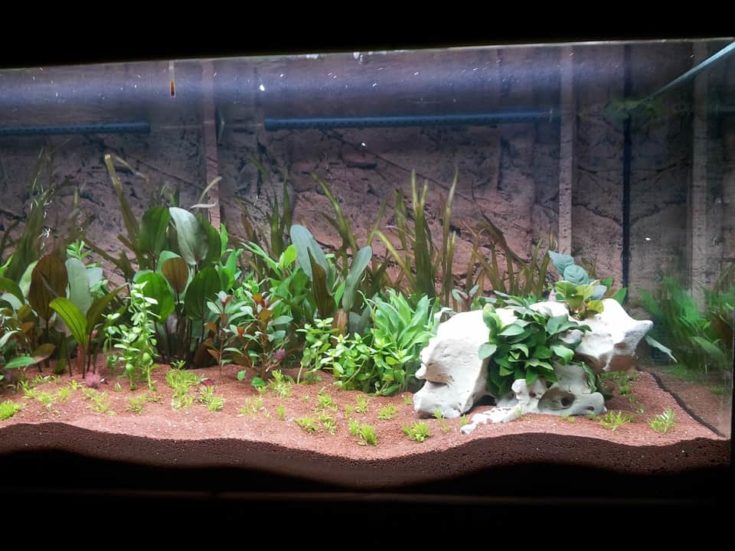
Although some tropical fish, such as Cardinal tetras, live in naturally stained “blackwater” in their wild Amazonian environment, tea-colored water can spoil the look of your tank. So, either use activated carbon in your filter system to remove the tannins or stick to using driftwood.
Plants
Living plants bring an attractive, natural feel to your tank. Fish love plants too, using the leaves as hideouts or resting places.
There are many different plant species that can be grown successfully in the tropical home aquarium by novice hobbyists without the need for the addition of supplements. Most plants need a small amount of basic maintenance, including trimming away dead leaves and thinning out overgrowth.
When choosing fish species, check that your favorites are compatible with a planted tank. Some fish, including goldfish, can be destructive, digging up plants and even eating some of the tender leaves.
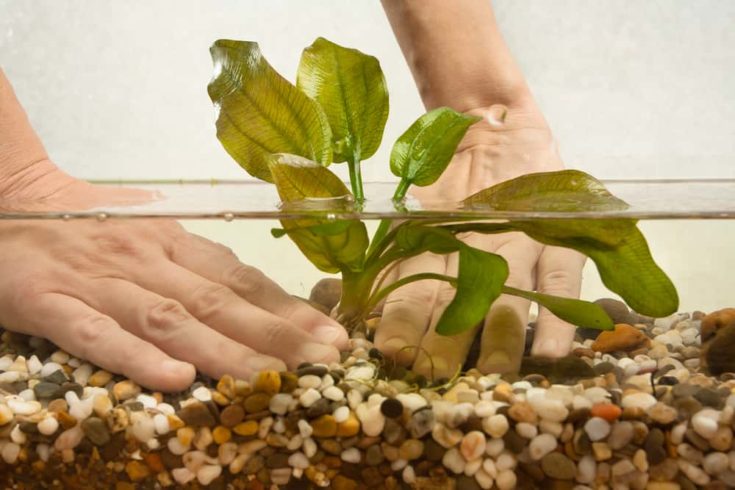
As an alternative to living plants, you could try using silk plants instead, which require no maintenance. I would advise against using plastic plants, as they can have sharp leaves that may injure your fish.
Other Essentials
Water test kits are essential if you have a new aquarium. The water can appear to be crystal clear but it may still be full of harmful nitrates that could make your fish sick. Also, a new biological filtration system takes time to mature, and testing the water in the tank each week will show you how well your filter is performing.
You will need a fish catching net for use if you need to catch your fish for a tank move or if one of your pets becomes sick. Choose a net that has a wider diameter than your largest fish. An algae magnet is also essential so that you can clean green algae from your tank glass as part of your weekly maintenance routine.
The most efficient way of cleaning your aquarium gravel and carrying out weekly partial water changes is to use an aquarium gravel vacuum. This simple device allows you to suck up fish waste and general detritus from the gravel while simultaneously removing water.
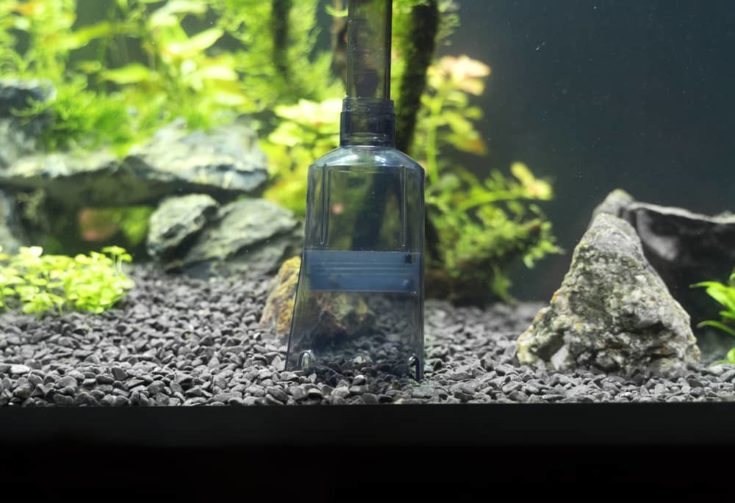
Finally, you’ll need an aquarium thermometer so that you can check the water temperature daily.
Introduce The Fish
Now it’s time to start stocking your tank!
Begin by adding just a few small fish to the tank. That allows the biological filter time to cope with the additional workload of fish waste in the water. If you add too many fish too soon, you risk exposing the fish to harmful levels of ammonia and nitrites in the water.
Taking it slowly also enables the fish to settle in without the stress of a crowd. Schooling species such as tetras and guppies are a good place to start, as safety in numbers means that the new arrivals will settle more quickly.
Over the next few weeks, you can introduce small numbers of different fish species to your community.
When you buy your fish, they will be placed in a plastic bag for transportation. Float the bag in your tank with the fish still inside it for 30 minutes or so before releasing them into the aquarium. That allows the temperatures in the bag and the aquarium to equalize, reducing the likelihood of your fish suffering from temperature shock.
Understanding Water Chemistry
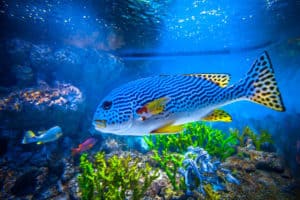
Water can be hard or soft, depending on the amounts of certain minerals it contains, including calcium carbonate. Water also has a pH level. The pH of water determines its degree of alkalinity, acidity, or whether it is neutral.
Different fish species have different tolerances when it comes to water chemistry. So, before you buy your fish, check the hardness and pH of your aquarium water to make sure that the fish you choose will be happy in that environment.
It is possible to add buffer chemicals to the water to alter the pH, but it’s less hassle to choose the right fish for the environment that you can provide.
Filtration And The Nitrate Cycle
Your filter keeps your fish tank clean, getting rid of uneaten food, harmful bacteria, fish waste, and chemicals. The filter pulls water and waste products through various media to purify it, preventing ammonia, nitrites, and nitrates from building up in the water, which is crucial to the health of your fish.
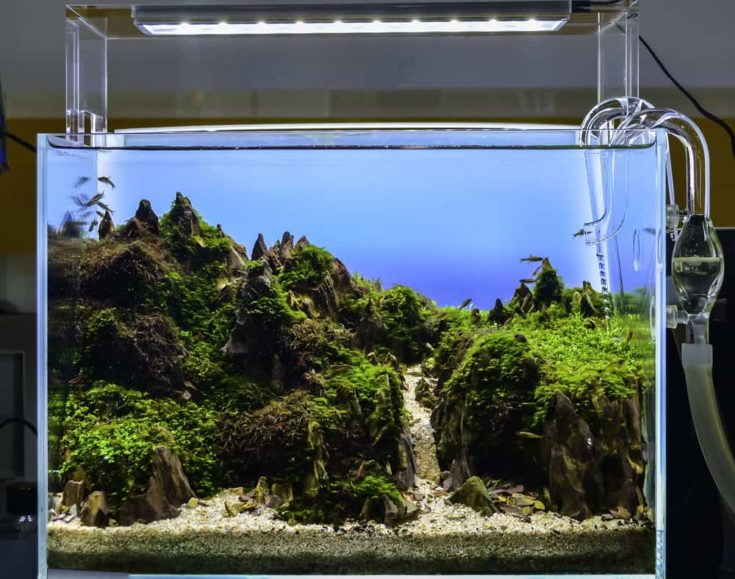
Also, stagnant water absorbs CO2 from the air, which changes the pH of the water and deprives the fish of the oxygen that they need to survive. Your filtration system ensures that the water keeps moving, drawing oxygen into the water as it does so.
The best filters have three stages; mechanical, biological, and chemical.
Mechanical Filtration
Mechanical filtration facilitates the removal of fish waste, uneaten food, and general detritus from the aquarium. To ensure that the filter works to its optimum, you need to change the filter cartridges once a month or so, depending on the system. Each week, rinse the filter media in tank water to remove any muck that could clog the filters and prevent the free flow of water through the system.
Biological Filtration
The biological filter is essential for your fishes’ health. Special biological sponges within the filter encourage “good” bacteria to grow in the aquarium. Those beneficial bacteria help to break the nitrogen cycle, keeping the water safe for your fish and living plants.
Chemical Filtration
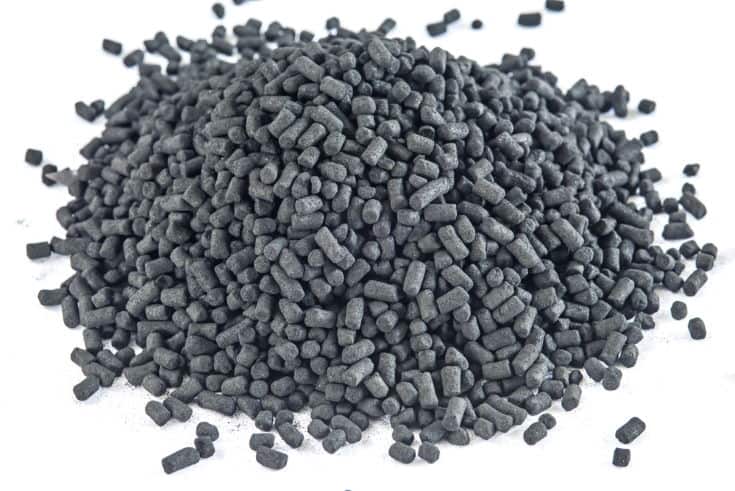
The chemical filtration part of the system is responsible for extracting harmful chemicals from the water. Activated charcoal is usually used for this phase of the filter system as it’s very effective in keeping the water safe for your fish.
The Nitrogen Cycle
As your aquarium becomes established, it accumulates fish waste, rotting food, dead organisms, and plant debris. All that matter is broken down by bacteria to form ammonia. Ammonia is highly toxic to everything that lives in the aquarium, particularly your fish. In a perfect situation, the ammonia levels in your tank should be zero.
Ammonia is broken down by a bacterium called Nitrosomonas to form nitrite. Nitrites aren’t as dangerous to life as ammonia but they are still toxic to your fish, and ideally, nitrite levels should be 0ppm (parts per million).
The final element of the nitrogen cycle sees the nitrite broken down by another bacterium called Nitrobacter to form nitrates. Nitrates aren’t as dangerous to your fish as nitrite and ammonia, but they do cause algae to bloom in the water, and the levels should preferably be kept below 20ppm.
So, you must test your water every week to make sure that ammonia and nitrite levels are 0ppm and nitrates are below 20ppm.
Tank Maintenance
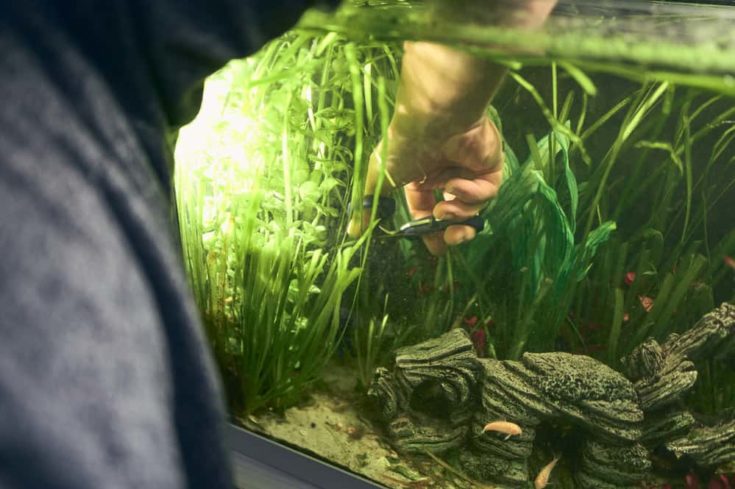
Maintaining your aquarium properly is vital if your fish are to remain in good health.
Essentially, tank maintenance is a weekly job:
- Start by cleaning the aquarium glass to remove algae and biofilm. The easiest way to do that is by using an aquarium magnet.
- If you have living plants in your tank, remove any dead leaves or overgrowth. Remove ornaments and rocks, and scrub away any algae using an old toothbrush. Stubborn stains can be shifted using distilled white vinegar.
- Switch off the tank lighting and remove the lid. Clean any algae that are growing on the cover slide, and remove hard water stains.
- Switch off the filtration system.
- Using an aquarium vacuum, clean the gravel, and siphon off a bucketful of water.
- Remove the filtration unit from the tank. Take the filter media out of the housing and wash it through in the bucket of dirty tank water. The idea here is to remove any build-up of gunk so that water can flow freely through the system. Check to see that the pump’s impeller is unobstructed and free from debris. If necessary, use an old toothbrush to carefully dislodge dirt, and rinse the impeller in tank water. Discard the dirty water.
- Replace the filter media in the housing and replace the unit in the tank.
- Partial water changes are crucial to remove accumulated nitrates from the water, so, continue cleaning the gravel until you have removed around 25% to 30% of the water in the tank.
- Top up the aquarium with fresh tap water that you’ve treated with dechlorinator.
- Switch the filtration unit on again, check to see that it’s working correctly, and replace the tank lid and light fitting.
In Summary
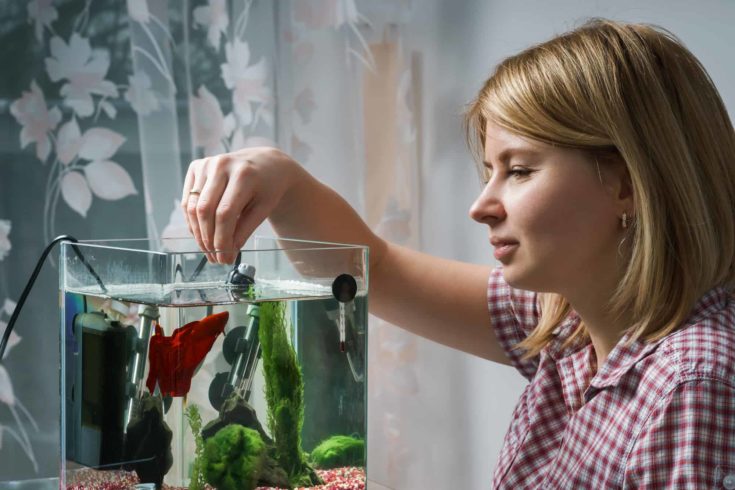
Fishkeeping is a rewarding, fun hobby that your whole family can enjoy. In our guide, we’ve included everything that you need to know to become a successful aquarist. Here’s a reminder of the key points:
- Decide where you want to put your fish tank and, based on that, decide what size aquarium you can have.
- Choose hardy, compatible, peaceful fish species.
- Assemble the essential equipment you’ll need.
- Set up your tank as shown in our guide.
- Cycle the tank for a week before adding your fish.
- Add a few fish each week so that you don’t overload your filtration system.
- Carry out weekly aquarium maintenance tasks to keep your fish happy and healthy.
I hope you enjoyed my ultimate guide to being an aquarist!
Please share your thoughts, experiences, and tips in the comments box below, and don’t forget to share this article with other fishkeeping enthusiasts!
Check out our infographic and don’t forget to share!
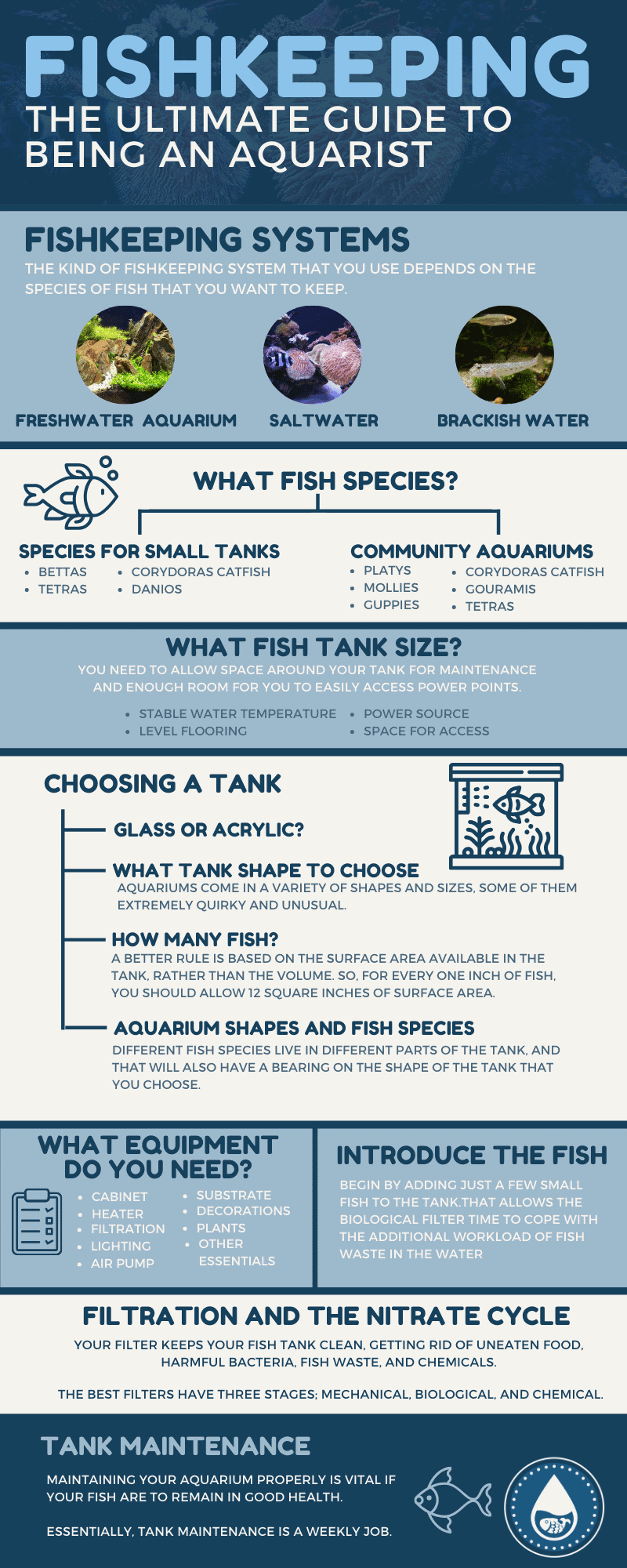
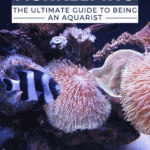
I have a future pair of king and queen paradise gourami fish, 2 white cloud tetras 2 cherry tetras 2 platyfish 2 guppies 2 Dwarf algea eaters and 1 single male future dragonfish of Australia Empire gudgeon fish.
Seems like people that have Empire gudgeon fish fear the king paradise gourami fish 😊😊😊😊😊😊😊😊😊😊😊😊😊😊😊😊😊😊😊😊😊😊😊